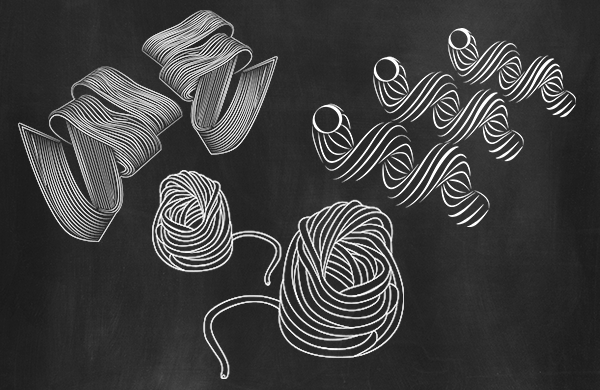 How many pasta shapes do you know by name? Sure, you're probably familiar with the common types like spaghetti, penne, and linguini, but what if I told you that there are more than 350 different types of pasta and that many of them go by several different names?
How many pasta shapes do you know by name? Sure, you're probably familiar with the common types like spaghetti, penne, and linguini, but what if I told you that there are more than 350 different types of pasta and that many of them go by several different names?
We'd never ask you to memorize 900+ pasta shapes and names, but we figured everyone could use a quick crash course covering the types of pasta you're most likely to spot on the menu in your favorite Italian restaurant. Study up, then task yourself with trying them all (you know, for research).

Agnolotti
Other names: piat d'angelot, angelotti, agnelotti, agnulot, langaroli, langheroli
What it looks like: a square shaped noodle with a pocket that's stuffed with meat. The terms agnolotti and ravioli are often used interchangably since their shape is very similar; however, the difference between the two is that agnolotti almost never features a cheese in its filling.

Bucatini
Other names: perciatelli
What it looks like: like spaghetti, only thicker and with a hollow center ("buco" means "hole" in Italian).

Cavatappi
Other names: cellentani, serpentini, trivelle, stortelli, spirali, double elbows, amori
What it looks like: like macaroni, only spiral shaped. The word "cavatappi" means "corkscrew" in Italian; however when most people talk about corkscrew shaped pasta, they're usually talking about fusilli, which is a flat, twisted noodle. Cavatappi, on the other hand, is a hollow, spiral-shaped tube. Confusing!

Cavatelli
Other names: orecchie di prete
What it looks like: a scalloped body with a slice down the middle. In certain regions of Italy, cavatelli may be very long and thin, but still feature the characteristic hollow down the center.

Conchiglie
Other names: pasta shells
What it looks like: like a conch shell, of course.

Ditalini
Other names: tubettini
What it looks like: a very tiny short tube. Translated into English, "ditalini" means "small thimbles", but the pasta more accurately resembles a tiny, hollow peg. In Italy, it is commonly used in soups, while in America, you might find it used to make macaroni salad (go figure).

Farfalle
Other names: bow-tie pasta, strichetti
What it looks like: a tiny bow tie with scalloped edges! However, the word "farfalle" actually means "butterflies", so it turns out we've all been misinterpreting this pasta's shape for years!

Fusilli
Other names: rotini
What it looks like: a corkscrew. The term fusilli is generally used to describe a screw-shaped pasta made from a flat noodle, whereas hollow, tubular screw-shaped pastas go by other names such as cavatappi or fusilli bucati.

Gnocchi
Other names: gnudi, malfatti
What it looks like: a small, soft dumpling made from potato, semolina, or ricotta. The tiny mounds of dough are thick and usually about the size of a cork.

Orecchiette
Other names: recchietelle, stacchiodde
What it looks like: a tiny, curved disc with a hollow in the center. The name literally translates to "tiny ear".

Pappardelle
Other names: none
What it looks like: very wide fettuccine. In some cases, the flat noodles can be as wide as three centimeters and may have fluted edges.

Tagliatelle
Other names: pizzoccheri, tagliolini
What it looks like: long, flat, and ribbon-shaped. Similar to fettuccine, but rolled out slightly thinner.

Ziti
Other names: boccolotti, zitoni, zituane, candele
What it looks like: a smooth, hollow tube with a straight-cut edge. Though they all have slight differences in shape, length, and texture, tube-shaped pastas like ziti, penne, rigatoni, and mostacchioli are all often used in the same recipes, and their names are frequently confused. To make things even more confusing, consider this: ziti are really just very short, wide bucatini OR extra long ditatini!








